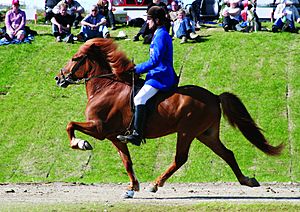Pony facts for kids
A pony is a type of small horse. Ponies are different from regular horses because they are smaller. They also have special features like thick manes, tails, and coats.
Ponies often have shorter legs and wider bodies. They also have strong bones and thicker necks. Their heads are usually shorter with wider foreheads. The word "pony" comes from an old French word meaning "foal" (a baby horse). But today, a pony is a small adult horse, not a young one. Sometimes, people who don't know much about horses might confuse an adult pony with a foal.
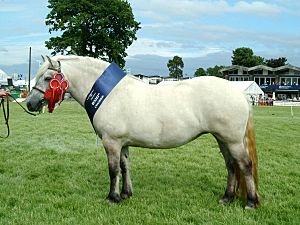
Most modern ponies became small because their ancestors lived in tough places. These smaller animals were tamed by humans. They were then bred for many different jobs across the Northern hemisphere. In the past, ponies pulled carts and carried goods. They were also used for children to ride and for fun. Later, they became competitors in sports. During the Industrial Revolution in Great Britain, many ponies worked in mines. They were called pit ponies and hauled coal.
Ponies are usually smart and friendly. Some people might say they are stubborn or clever. When trained well, ponies are great for children learning to ride. Even adults can ride larger ponies because ponies are very strong for their size. Many groups say a pony is a horse that is less than 14.3 hands (59 inches, 150 cm) tall at its withers. The withers is the highest part of a horse's back, between its shoulder blades. But there are some exceptions to this rule. Some horse breeds are called "ponies" no matter their height.
Contents
Ponies and Horses: What's the Difference?
For many horse competitions, a pony is officially a horse that measures less than 14.2 hands (58 inches, 147 cm) at the withers. Regular horses are 14.2 hands or taller. The International Federation for Equestrian Sports (FEI) has a specific height rule. They say the cutoff is 148 centimetres (58.27 in) (just over 14.2 hands) without shoes. It's 149 centimetres (58.66 in) (just over 14.2–1/2 hands) with shoes.
However, the word "pony" can also be used in a general way. People might call any small horse a "pony" as a friendly nickname. Also, some horse breeds have members that are shorter than 14.2 hands. But they are still called "horses" and can compete as horses. In Australia, horses between 14 and 15 hands are called "galloways." Ponies in Australia are under 14 hands.
People who are new to horses might mix up an adult pony with a young horse, called a foal. Foals that will grow into full-sized horses might be as short as some ponies when they are very young. But their bodies look very different. A pony is fully grown and can be ridden or put to work. A foal is too young for this.
Foals, whether they will be horse-sized or pony-sized, have very long legs and thin bodies. Their heads and eyes also look like those of a baby animal. Most foals will be very close to their mother, called a mare. Ponies, even though they are small, have body shapes similar to adult horses.
Pony History
Ponies first developed naturally in tough environments. They were a type of "draft" animal common in Northern Europe. People needed a working animal that could handle local jobs. They also needed an animal that could live in harsh conditions. Farmers noticed that ponies could do more work than larger draft horses on small farms.
Over time, people started to breed ponies for different reasons. By the 1900s, many pony breeds had Arabian horse blood added. This made them more refined and better for riding.
What Ponies Are Used For
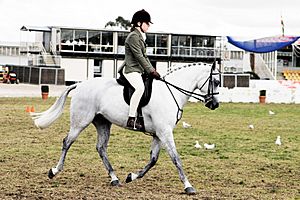
Ponies are used in many different horse activities. Some breeds, like the Hackney pony, are mostly used for pulling carts. Other breeds, like the Connemara pony and Australian Pony, are mainly used for riding. Breeds like the Welsh pony are good for both riding and driving.
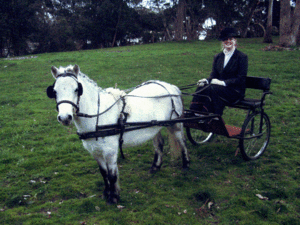
A horse's size doesn't always show how good it is at sports. Ponies compete in many events. These include show hunter and English riding classes. They also do driving and western riding at horse shows. Ponies compete in fun events like gymkhana and combined driving.
Ponies are also great for casual activities like trail riding. Some ponies have even competed at international levels. For example, a 14.1-hand pony named Stroller won a silver medal in show jumping at the 1968 Summer Olympics. More recently, a pony named Theodore O'Connor won a gold medal in eventing at the 2007 Pan American Games.
Pony Clubs are groups for young people who own horses or ponies. These clubs teach kids about horses and how to care for them. They also hold competitions for young riders and their smaller horses.
In many parts of the world, ponies still work. They are used as pack animals to carry things. They also pull different horse-drawn vehicles. You might see ponies giving rides to children at traveling carnivals or parties. Sometimes, ponies are used at summer camps for kids. They are also popular for pony trekking and other riding holidays. Ponies often carry adults as well as children on these trips. In India, ponies are used to carry pilgrims to Kedarnath.
Pony Characteristics
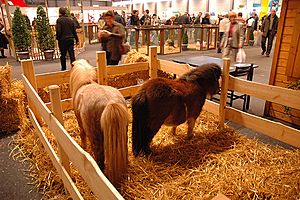
Ponies are often known for their strong, stocky bodies. They have dense bones and a round shape with well-sprung ribs. Their heads are short, with large eyes and small ears. Besides being smaller than horses, their legs are also shorter in proportion. They have strong hooves. Ponies also grow a thick hair coat, with a very thick mane and tail. They get a particularly heavy winter coat.
Pony breeds have developed all over the world. They are common in cold and harsh places where tough, strong working animals were needed. Ponies are incredibly strong for their size. Breeds like the Connemara pony are known for being able to carry a full-sized adult rider. Pound for pound, ponies can pull and carry more weight than a horse. Draft-type ponies can pull loads much heavier than themselves. Larger ponies can even pull loads similar to those pulled by full-sized draft horses. Even very small ponies can pull up to 450 percent of their own weight.
Almost all pony breeds are very hardy and "easy keepers." This means they can live well on less food than a regular horse. They need about half the hay for their weight compared to a horse. Often, they don't need grain at all. However, because of this, they are more likely to get certain health problems. These include laminitis and Cushing's syndrome. They might also have problems with hyperlipemia.
Ponies are generally thought to be smart and friendly. But sometimes, they are described as stubborn or cunning. These different opinions often depend on how well a pony has been trained. Ponies trained by people without much experience, or only ridden by beginners, can become spoiled. This is because their riders might not know how to correct bad habits. When trained properly, ponies are excellent for children learning to ride. Adults can ride larger ponies because ponies are usually very strong for their size.
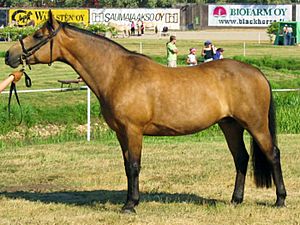
For horse shows, ponies are often put into three size groups: small, medium, and large.
- Small ponies are 12.2 hands (50 inches or 127 cm) and under.
- Medium ponies are over 12.2 hands but no taller than 13.2 hands (54 inches or 137.16 cm).
- Large ponies are over 13.2 hands but no taller than 14.2 hands (58 inches or 147.32 cm).
The smallest horses are often called miniature horses by their breeders. They are usually no taller than 38 inches (97 cm) at the withers. This is even smaller than small ponies. However, there are also miniature pony breeds.
Breeds Not Always Called Ponies
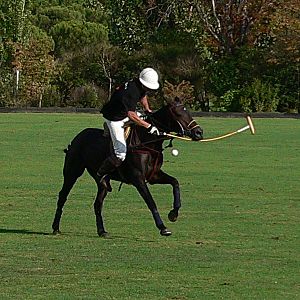
Some horse breeds are not called ponies, even if some of their members are under 14.2 hands. This is usually because of their body shape, traditional uses, and overall features. Breeds considered horses regardless of height include the Arabian horse, American Quarter Horse, and the Morgan horse. These breeds have individual horses both over and under 14.2 hands.
Other horse breeds, like the Icelandic horse and Fjord horse, might be pony-sized. They might also have some pony features, like a thick coat, thick mane, and strong bones. But their breed groups usually classify them as "horses." In these cases, there can be a lot of discussion about whether to call them "horses" or "ponies." However, the specific breed groups usually decide. They look at the horse and pony features of the breed. For some breeds, like the Welsh pony, this issue is solved by having separate groups. For example, the "Section D" Welsh Cob is for animals that are consistently horse-sized.
Some horses might be pony height because of their environment, not their genetics. For example, the Chincoteague pony is a feral horse that lives on Assateague Island in Virginia. If a Chincoteague foal is raised by humans, it often grows to the height of an average small horse.
Sometimes, the word "pony" is used for horses of normal height. Horses used for polo are often called "polo ponies." This is true even if they are often Thoroughbreds and much taller than 14.2 hands. American Indian tribes also traditionally call their horses "ponies" when speaking English. This is even though many of the Mustang horses they used in the 1800s were close to or over 14.2 hands. Most horses owned by Native peoples today are full horse height. The word "pony" is also sometimes used to describe a full-sized horse in a funny or loving way.
The United States Pony Club says a "pony" is any horse ridden by a member, no matter its breed or size. People up to 25 years old can join. Some of the members' "ponies" are actually full-sized horses.
Images for kids
See also
 In Spanish: Poni para niños
In Spanish: Poni para niños



